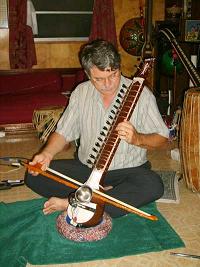
|
Tar shehanai is merely a small mechanical amplifier that has
been added to an esraj. One may think of the tar shehanai as having
the same relationship to the esraj as the dobro guitar has to a
standard acoustic guitar. Since the tar shehanai is just a modified
esraj there are really no significant differences in technique or
tuning. Therefore, one can read about the esraj for more
information. dobro guitar has to a
standard acoustic guitar. Since the tar shehanai is just a modified
esraj there are really no significant differences in technique or
tuning. Therefore, one can read about the esraj for more
information.History The history of the tar shehanai is not completely clear; but from what we do know, it is an interesting story. The story actually begins thousands of miles away in Europe and the United States. Since the third quarter of the 19th century, the introduction of the gramophone saw a need to develop more efficient ways of acoustically coupling the weak mechanical energies from the disks and cylinders to the air in the form of sound. During the later part of the 19th century and well into the 20th century, such efforts begin to bear fruit in the form of extremely efficient gramophone sound boxes. Around the turn of the 20th century, a few instrument makers began to realise that many of the same requirements of the gramophone also applied to musical instruments. Therefore, numerous instrument makers around Europe and the US almost simultaneously began to experiment with the use of gramophone sound boxes as a replacement for the more traditional wooden sound boxes that we have come to associate with guitars, violins, and other stringed instruments. There were a number of instruments that were based upon this approach. Today the Stroh violin is still in production. The Dobro guitar's "pan" also evolved from technologies that were developed for the gramophone. One of the most significant for the development of the tar shehnai, was an instrument that was known as the "Japanese fiddle".
These musical experiments we not done merely in the name of
innovation; they were spurred by very real musical and commercial
needs. The rapidly developing recording industry was having a very
difficult time recording stringed instruments. Although some
instruments such as the saxophone had a strong sound that was highly
directional and could be easily recorded, most of the stringed
instruments had sounds that were weak, diffuse, and non-directional.
The gramophone-soundbox instruments overcame these problems and were
easy to record.
The tar shehnai had a great popularity in the early days of the
film industry. Even with the introduction of vacuum tube (valve)
based electronic recording, the tar shehanai proved very easy to
work with in the studio. Furthermore, the very piercing sound
quality of the tar shehnai gave a certain "punch" to the musical
interludes in film songs. Therefore it should be no surprise that
the tar shehnai continued to be popular in film songs until about
the early 1960's. This was many decades after the introduction of
the vacuum tube removed the tar shehnai's very raison de etre.
|
||